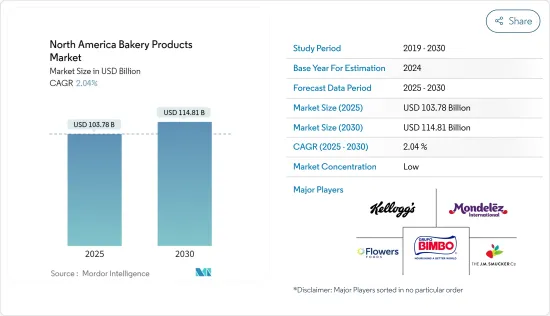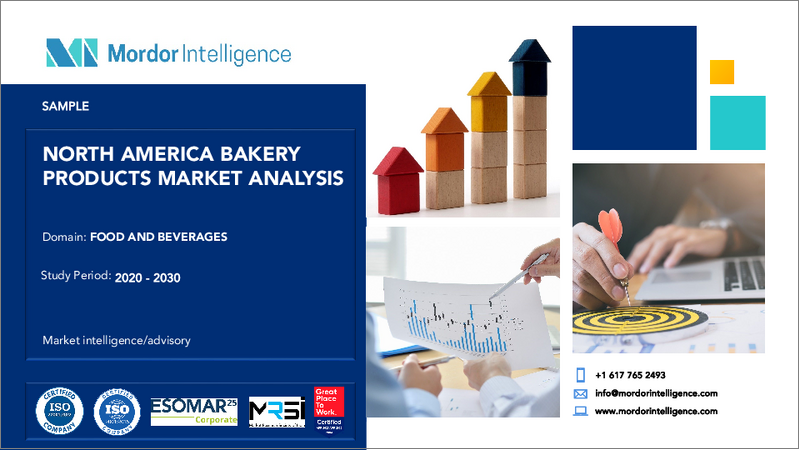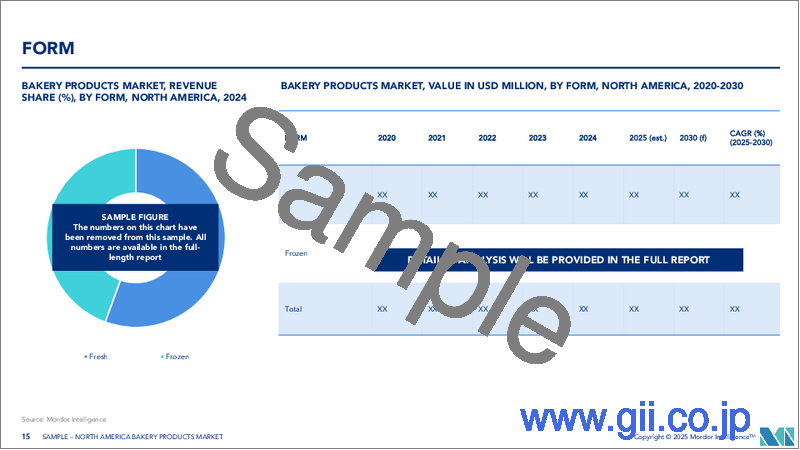|
|
市場調査レポート
商品コード
1687439
北米のベーカリー製品:市場シェア分析、産業動向&統計、成長予測(2025年~2030年)North America Bakery Products - Market Share Analysis, Industry Trends & Statistics, Growth Forecasts (2025 - 2030) |
||||||
カスタマイズ可能
適宜更新あり
|
|||||||
| 北米のベーカリー製品:市場シェア分析、産業動向&統計、成長予測(2025年~2030年) |
|
出版日: 2025年03月18日
発行: Mordor Intelligence
ページ情報: 英文 100 Pages
納期: 2~3営業日
|
全表示
- 概要
- 目次
北米のベーカリー製品市場規模は2025年に1,037億8,000万米ドルと推定され、予測期間中(2025年~2030年)のCAGRは2.04%で、2030年には1,148億1,000万米ドルに達すると予測されます。

北米のベーカリー市場を牽引しているのは、栄養価が高く利便性の高いベーカリー製品を求める消費者動向の変化です。健康、免疫力、エネルギーに関する意識の高まりが、グルテンフリー・タンパク質のベーカリー食品の需要を押し上げています。2023年現在、米国の成人人口の約1%がセリアック病に罹患しており、グルテンフリーのベーカリー製品に対する需要の増加を示しています。古代穀物、有機穀物、小麦粉のカスタム・ブレンドは、保存料が少なく、トランス脂肪酸が少なく、タンパク質が豊富で、必須微量栄養素を含む、最小限の加工を施した健康促進ベーカリー製品に対する需要の高まりにより、売上高が増加すると予想されます。
都市化と労働人口の増加により、家庭外消費が増加しており、インスタントで栄養価の高いベーカリー製品に対する需要が高まっています。この動向が北米におけるベーカリー製品の成長を後押ししています。商業ベーカリーは小売店より数は少ないが、この地域のベーカリー市場全体の利益のほぼ80%を生み出しています。商業ベーカリーは老舗であり、主要企業がシナリオを支配しているのに対し、小売店はより断片的です。また、スーパーマーケット、ハイパーマーケット、専門店、オンライン・デリバリーなど、さまざまな小売チェーンが存在することも、市場の成長を後押ししています。
北米のベーカリー製品市場動向
便利で健康的な間食の需要がモーニング商品の需要に影響
消費パターンの変化やポーションコントロールなどの概念に対する意識の高まりにより、簡便なスナック製品に対する需要が急増しています。カロリー不足の食生活の嗜好により、ベーカリー製品の小分け/持ち帰り用消費パックを提供するブランドが増加しています。北米の消費者は味、健康、利便性をますます重視するようになっており、忙しい日の食欲を満たしたり、多忙な日の食事代わりにしたりするために、持ち帰り用のベーカリー・スナックが消費者に選ばれることが多いです。そのため、消費者は朝食を選ぶようになります。米国は大食漢の国となり、人々は健康的なライフスタイルと高められた嗜好に合った解決策を求めています。タンパク質を多く含むスナックは、この地域、特に米国で人気を集めています。2023年、米国の消費者の間では、タンパク質ベースのスナック製品の消費はすべての年齢層で増加し、最も顕著なのは32~45歳でした。プロテイン・パンケーキはこの層で最も好まれるスナック製品のひとつであり、満腹感と朝の食事におけるタンパク質の重要性が強調されています。
米国では、天然素材やオーガニック素材を使用したベーカリー製品の需要が高まっています。このコンセプトは他の市場でも進化しています。人工添加物不使用、保存料不使用、非遺伝子組み換え、減糖など、さまざまな表示を謳った製品の発売が人気を集めています。その結果、栄養価の高い製品に対する消費者の要求が高まり、製品にクリーンラベルの謳い文句が増加したことで、この地域の市場成長が加速しました。このように、北米の消費者の間では、仕事と家庭生活の進化に伴う食事パターンの変化や外出先でのスナックに対する嗜好の高まりが、同地域におけるベーカリー製品の成長を後押ししています。
米国市場が同地域市場を独占する見通し
健康志向と嗜好性が米国のベーカリー市場を独占する2つの並行動向です。米国では、多忙な生活の増加や手早く簡単な食事への欲求から、家庭で素早く調理できたり外出先で手に取ったりできるベーカリー製品への需要が高まっています。労働人口の増加と消費者のライフスタイルの改善により、ヘルシーなパン、ピザロール、チキンパフ、マフィンなど、すぐに食べられる(RTE)食品の消費が国全体で拡大しています。さらに、国内ではパン職人の数が増加しているため、市場は成長を遂げています。その結果、ベーカリー製品の種類が増え、生産能力も向上しています。パン職人の増加は、ヘルシーな間食という新たな動向にも対応しています。この動向は、全粒粉、高繊維質、その他の健康増進成分を含む製品の発売によって促進されています。
焼き菓子の許容度は非常に高く、アメリカの消費者は日課の一部として時折焼き菓子を好みます。2022年7月、アメリカ・ベーカーズ・アソシエーションは、アメリカ人の84%がクッキー、カップケーキ、ドーナツ、パイなどの焼き菓子を時折自分へのご褒美として食べることを許容できると考えていると報告しました。アメリカのZ世代とミレニアル世代の顧客は、ピザ、フラットブレッド、ラップ、トルティーヤなどの焼き菓子を好みました。米国ベーカリー協会によると、ほぼ90%がこれらの商品を購入しています。コンビニエンス・ベーカリーや冷凍ベーカリー製品へのニーズが高まっており、市場拡大の原動力となっています。
北米ベーカリー製品産業概要
北米のベーカリー製品市場は、国ごとに地域や国内の有力企業が存在するため、断片化されています。合併、拡大、買収、提携、新製品開発は、主要企業が消費者の間でブランドの存在感を高めるために採用する戦略的アプローチです。市場を独占している主要企業には、ケロッグ・カンパニー、フラワー・フーズ・インク、グルポ・ビンボ、SABデCV、J.M.スマッカー・カンパニー(ホステス・ブランズ)、モンデリーズ・インターナショナル・インクなどがあります。いくつかのメーカーは、製品のオンライン・プロモーション、マーケティング、ブランディングのためにオンライン流通チャネルに注力しており、地理的なリーチを拡大し、顧客ベースを増やしています。
その他の特典:
- エクセル形式の市場予測(ME)シート
- 3ヶ月間のアナリスト・サポート
目次
第1章 イントロダクション
- 調査の前提条件と市場定義
- 調査範囲
第2章 調査手法
第3章 エグゼクティブサマリー
第4章 市場力学
- 市場促進要因
- 継続的な製品革新が市場成長を促進
- 多忙なスケジュールが消費者のベーカリー製品販売を促進
- 市場抑制要因
- 経済不安定が市場成長を阻害
- ポーターのファイブフォース分析
- 供給企業の交渉力
- 買い手の交渉力
- 新規参入業者の脅威
- 代替品の脅威
- 競争企業間の敵対関係の強さ
第5章 市場セグメンテーション
- 製品タイプ別
- ケーキとペストリー
- ビスケット
- パン
- モーニング
- その他
- 流通チャネル別
- スーパーマーケット/ハイパーマーケット
- コンビニエンスストア
- 専門店
- オンライン小売業者
- その他の流通チャネル
- 地域
- 米国
- カナダ
- メキシコ
- その他の北米地域
第6章 競合情勢
- 主要企業の戦略
- 市場シェア分析
- 企業プロファイル
- Mondelez International, Inc.
- The Kellogg Company
- The J.M. Smucker Company(Hostess Brands)
- Campbell Soup Company
- GRUMA S.A.B. de C.V.
- General Mills Inc.
- Grupo Bimbo S.A.B. de C.V.
- Alpha Baking Company Inc.
- Sara Lee Frozen Bakery
- Flowers Foods Inc.
第7章 市場機会と今後の動向
The North America Bakery Products Market size is estimated at USD 103.78 billion in 2025, and is expected to reach USD 114.81 billion by 2030, at a CAGR of 2.04% during the forecast period (2025-2030).

The bakery market in North America is driven by changing consumer trends for bakery products that offer high nutritional value and convenience. Growing consciousness regarding health, immunity, and energy boosts the demand for gluten-free protein baked foods. As of 2023, approximately 1% of the adult population in the United States had celiac disease, indicating increased demand for gluten-free bakery products. Ancient grains, organic grains, and custom blends of wheat flour are expected to record higher sales owing to the growing demand for health-promoting bakery products that are minimally processed with lesser preservatives, have lesser trans fats, are rich in protein, and have essential micronutrients.
Due to urbanization and the increase in the working population, the growth of out-of-home consumption is rising, increasing the demand for instant and nutritious bakery products. This trend is fueling the growth of bakery products in North America. Commercial bakeries, although fewer in numbers than retail stores, generate almost 80% of the total bakery market profits in the region. Commercial bakeries are well-established, with key players dominating the scenario, whereas retail stores are more fragmented. Also, the availability of various retail chains like supermarkets, hypermarkets, specialty stores, and online delivery boosts the market's growth.
North America Bakery Products Market Trends
Demand For Convenient and Healthy Snacking is Impacting the Demand for Morning Goods
The demand for convenience snack products is growing rapidly due to changes in consumption patterns and increasing awareness about concepts like portion control. A calorie deficit dietary preference is driving a more significant number of brands to offer small/on-the-go consumption packs of bakery products. North American consumers are increasingly focusing on taste, health, and convenience, and grab-and-go bakery snacks are often picked by consumers to quench appetites on busy days or to replace their meals on hectic days. This drives the consumer to choose morning goods. The United States has become a nation of grazers, with people looking for solutions that fit their healthy lifestyles and elevated tastes. Snacks high in protein are gaining traction in the region, especially in the United States. In 2023, among US consumers, the consumption of protein-based snack products rose across all age groups, with the most prominent being among people aged 32-45 years. Protein pancakes were among this group's most favored snack products, underscoring the importance of protein for satiety and the morning meal.
Bakery products claiming to contain natural and organic ingredients witnessed increased demand in the United States. This concept has been evolving across other markets as well. Product launches with various label claims, such as no artificial additives, no preservatives, non-GMO, and reduced sugar, are becoming increasingly popular. As a result, the increased consumer demand for nutritious products and the rising clean-label claims on products accelerated the market growth in this region. Thus, the change in eating patterns and the growing preference for on-the-go snacks among North American consumers due to the evolution of work and home life are propelling the growth of bakery products in the region.
The US Market is Expected to Dominate the Regional Market
Health consciousness and indulgence are two parallel trends dominating the US bakery market. The demand for bakery products that can be rapidly prepared at home or grabbed on the go has increased in the United States due to an increase in busy lives and the desire for quick and simple meals. The growing working population and improving consumer lifestyles have enhanced the consumption of ready-to-eat (RTE) food products such as healthy bread, pizza rolls, chicken puffs, and muffins throughout the country. Further, the market is experiencing growth due to the increasing number of bakers in the country. This has resulted in a wider range of bakery goods and increased production capacity. The increase in the number of bakers also caters to the emerging trend of healthy snacking. This trend is fueled by the launch of products that contain wholegrain, high fiber, or other health-promoting ingredients.
Baked goods have very high permissibility, and American consumers prefer the occasional baked treat as part of their daily routine. In July 2022, the American Bakers Association reported that 84% of Americans considered it acceptable to occasionally treat themselves to baked goods like cookies, cupcakes, doughnuts, or pies. American Gen Z and millennial customers preferred baked goods such as pizza, flatbreads, wraps, and tortillas. Almost 90% purchased a selection of these products, according to the American Bakers Association. The need for convenience and frozen bakery products is increasing, driving market expansion.
North America Bakery Products Industry Overview
The North American market for bakery products is fragmented, owing to the presence of prominent regional and domestic players in different countries. Mergers, expansion, acquisitions, partnerships, and new product development are strategic approaches adopted by leading companies to boost their brand presence among consumers. Key players dominating the market include The Kellogg Company, Flower Foods Inc., Grupo Bimbo, SAB de CV, The J.M. Smucker Company (Hostess Brands), and Mondelez International Inc. Several manufacturers are focusing on online distribution channels for their online promotion, marketing, and branding of their products, to expand their geographic reach and increase their customer base.
Additional Benefits:
- The market estimate (ME) sheet in Excel format
- 3 months of analyst support
TABLE OF CONTENTS
1 INTRODUCTION
- 1.1 Study Assumptions and Market Definition
- 1.2 Scope of the Study
2 RESEARCH METHODOLOGY
3 EXECUTIVE SUMMARY
4 MARKET DYNAMICS
- 4.1 Market Drivers
- 4.1.1 Continuous Product Innovations Aiding Market Growth
- 4.1.2 Hectic Schedules Fuels Bakery Products Sales Among Consumers
- 4.2 Market Restraints
- 4.2.1 Economic Instability Impedes Market Growth
- 4.3 Porter's Five Forces Analysis
- 4.3.1 Bargaining Power of Suppliers
- 4.3.2 Bargaining Power of Buyers
- 4.3.3 Threat of New Entrants
- 4.3.4 Threat of Substitute Products
- 4.3.5 Intensity of Competitive Rivalry
5 MARKET SEGMENTATION
- 5.1 By Product Type
- 5.1.1 Cakes and Pastries
- 5.1.2 Biscuits
- 5.1.3 Bread
- 5.1.4 Morning Goods
- 5.1.5 Others
- 5.2 By Distribution Channel
- 5.2.1 Supermarkets/Hypermarkets
- 5.2.2 Convenience Stores
- 5.2.3 Specialist Stores
- 5.2.4 Online Retailers
- 5.2.5 Other Distribution Channels
- 5.3 Geography
- 5.3.1 United States
- 5.3.2 Canada
- 5.3.3 Mexico
- 5.3.4 Rest of North America
6 COMPETITIVE LANDSCAPE
- 6.1 Strategies Adopted By Leading Players
- 6.2 Market Share Analysis
- 6.3 Company Profiles
- 6.3.1 Mondelez International, Inc.
- 6.3.2 The Kellogg Company
- 6.3.3 The J.M. Smucker Company (Hostess Brands)
- 6.3.4 Campbell Soup Company
- 6.3.5 GRUMA S.A.B. de C.V.
- 6.3.6 General Mills Inc.
- 6.3.7 Grupo Bimbo S.A.B. de C.V.
- 6.3.8 Alpha Baking Company Inc.
- 6.3.9 Sara Lee Frozen Bakery
- 6.3.10 Flowers Foods Inc.





